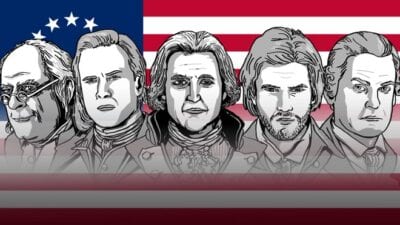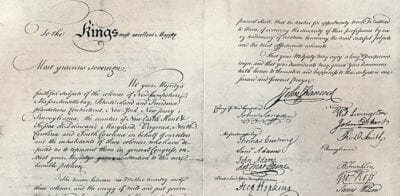A secret group of politically dissident colonists formed in the Thirteen American Colonies during the early days of the American Revolution dedicated to fighting against taxes imposed on them by the British government. From the group’s own constitution signed in early 1766, it is clear that the Sons of Liberty had no intention of starting a revolution. “That we have the highest esteem of his most sacred Majesty, King George the Third, the Sovereign Protector of our Rights, and the succession by Law established, and will bear true Allegiance to him and his Royal house forever,” states the document. While the group’s action helped fan the flames of revolution, The Sons of Liberty demanded only that the colonists be treated fairly by the British government.
The group is best known for leading the colonists’ opposition to the British Stamp Act of 1765, and for its still often-quoted rallying cry of, “No Taxation without Representation.”
While the Sons of Liberty officially disbanded after the repeal of the Stamp Act, later separatist groups used the name to anonymously summon followers to gather at the “Liberty Tree,” a famed elm tree in Boston believed to have been the site of the first acts of rebellion against the British government.
In 1765, the American colonies were protected by more than 10,000 British soldiers. As the expenses involved in quartering and equipping these soldiers living in the colonies continued to grow, the British government decided that the American colonists should pay their share. Hoping to accomplish this, the British Parliament enacted a series of taxes aimed solely at the colonists. Many colonists vowed not to pay the taxes. Having no representative in Parliament, the colonists felt the taxes had been enacted without any form of their consent. This belief led to their demand for, “No Taxation without Representation.”
By far the most hotly-opposed of these British taxes, the Stamp Act of 1765 required that many printed materials produced in the American colonies be printed only on paper made in London and bearing an embossed British revenue stamp. The stamp was required on newspapers, magazines, pamphlets, playing cards, legal documents, and many other items printed in the colonies at the time. In addition, the stamps could be purchased only with valid British coins, rather than the more easily available colonial paper currency.
The Stamp Act triggered a rapidly-growing torrent of opposition throughout the colonies. Some colonies passed legislation officially condemning it, while the public responded with demonstrations and occasional acts of vandalism. By the summer of 1765, the several scattered groups organizing demonstrations against the Stamp Act came together to form the Sons of Liberty.
While much of the history of Sons of Liberty remains clouded by the same secrecy in which it was born, the group was originally founded in Boston, Massachusetts during August 1765 by a group of nine Bostonians who referred to themselves as the “Loyal Nine.” It is believed that the original membership of the Loyal Nine consisted of:
- Benjamin Edes, the publisher of the Boston Gazette
- Henry Bass, a merchant, and cousin of Samuel Adams
- John Avery Jr, a distiller
- Thomas Chase, a distiller
- Thomas Crafts, a painter
- Stephen Cleverly, a brass craftsman
- John Smith, a brass craftsman
- Joseph Field, a ship’s captain
- George Trott, a jeweler
- Either Henry Welles, a mariner, or Joseph Field, a ship’s master
Since the group purposely left few records, it is not known exactly when the “Loyal Nine” became “The Sons of Liberty.” However, the term was first used by Irish politician Isaac Barre in February 1765 during a speech to the British Parliament. Supporting the American colonists in their opposition to the Stamp Act, Barre told Parliament:
“[Were] they [the colonists] nourished by your indulgence? They grew by your neglect of them. As soon as you began to care about them, that care was exercised in sending persons to rule over them, in one department and another… sent to spy out their liberty, to misrepresent their actions and to prey upon them; men whose behavior on many occasions has caused the blood of these sons of liberty to recoil within them…”
What had been vocal opposition to the Stamp Act turned to violence in Boston on the morning of August 14, 1765, when protesters believed to be Sons of Liberty members attacked the home of local British stamp distributor Andrew Oliver.
The rioters started by hanging a likeness of Oliver from the famed elm tree known as the “Liberty Tree.” Later in the day, the mob dragged Oliver’s effigy through the streets and destroyed the new building he had built to use as his stamp office. When Oliver refused to resign, the protestors beheaded his effigy in front of his fine and costly home before breaking out all of the windows, destroying the carriage house and stealing the wine from the wine cellar.
Having clearly received the message, Oliver resigned the next day. However, Oliver’s resignation was not the end of the riot. On August 26, another group of protesters pillaged and virtually destroyed the stately Boston home of Lieutenant Governor Thomas Hutchinson – Oliver’s brother-in-law.
Similar protests in other colonies forced more British officials to resign. At colonial seaports, incoming ships loaded with British stamps and paper were forced to return to London.
By March 1765, the Loyal Nine had become known as the Sons of Liberty, with groups known to have formed in New York, Connecticut, New Jersey, Maryland, Virginia, Rhode Island, New Hampshire, and Massachusetts. In November, a committee had formed in New York to coordinate secret correspondence between the rapidly spreading Sons of Liberty groups.
Between October 7 and 25, 1765, elected delegates from nine colonies convened the Stamp Act Congress in New York for the purpose of devising a unified protest against the Stamp Act. The delegates drafted a “Declaration of Rights and Grievances” affirming their belief that only the locally-elected colonial governments, rather than the British Crown, had the legal authority to tax the colonists.
Over the coming months, boycotts of British imports by colonial merchants encouraged merchants in Britain to ask Parliament to repeal the Stamp Act. During the boycotts, colonial women formed local chapters of the “Daughters of Liberty” to spin cloth to substitute for the blocked British imports.
By November 1765, the combination of violent protests, boycotts, and resignations of British stamp distributors and colonial officials was making it increasingly difficult for the British Crown to implement the Stamp Act.
Finally, in March 1766, after an impassioned appeal by Benjamin Franklin before the British House of Commons, Parliament voted to repeal the Stamp Act almost a year to the day after it had been enacted.
In May 1766, after learning of the repeal of the Stamp Act, members of the Sons of Liberty gathered under the branches of the same “Liberty Tree” from which they had hanged Andrew Oliver’s effigy on August 14, 1765, to celebrate their victory.
Following the end of the American Revolution in 1783, the Sons of Liberty was revived by Isaac Sears, Marinus Willet, and John Lamb. In a March 1784 rally in New York, the group called for the expulsion of any remaining British loyalists from the state.
In an election held on December 1784, members of the new Sons of Liberty won enough seats in the New York legislature to pass a set of laws intended to punish the remaining loyalists. In violation of the Revolution-ending Treaty of Paris, the laws called for all property of the loyalists to be confiscated. Citing the authority of the treaty, Alexander Hamilton successfully defended the loyalists, paving the road to lasting peace, cooperation, and friendship between America and Britain.



